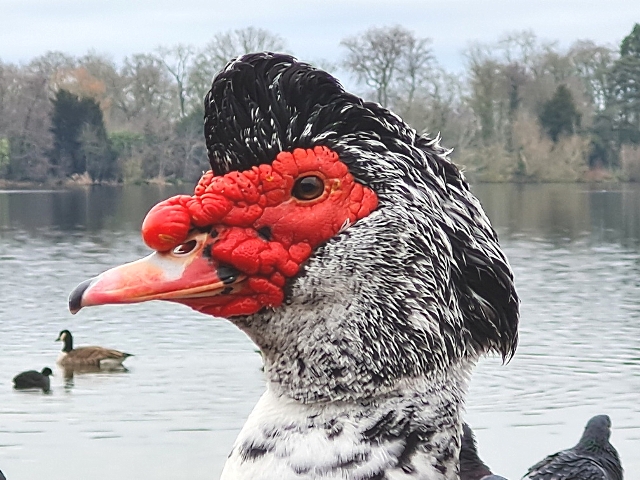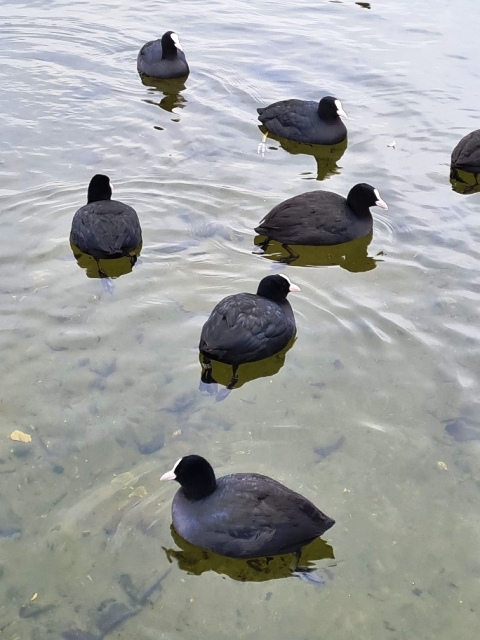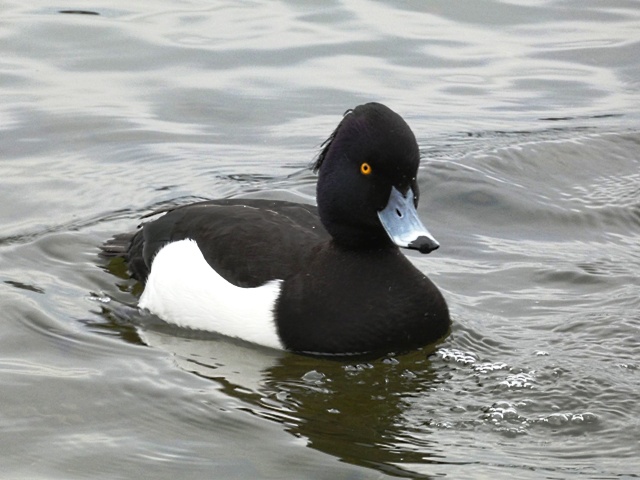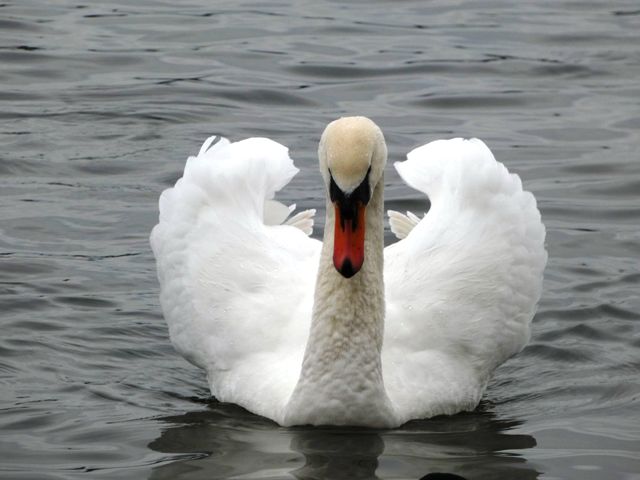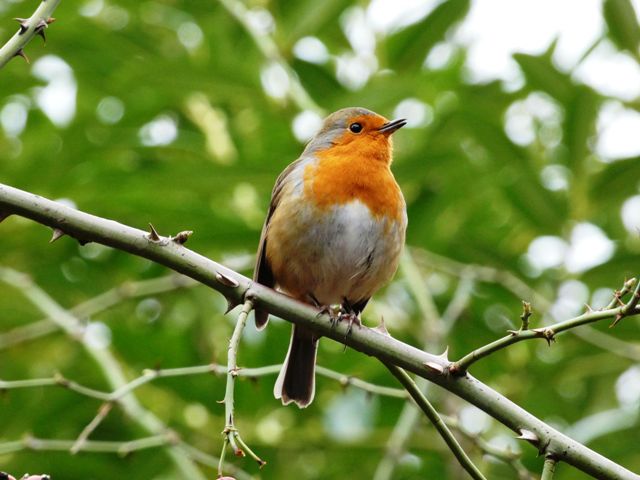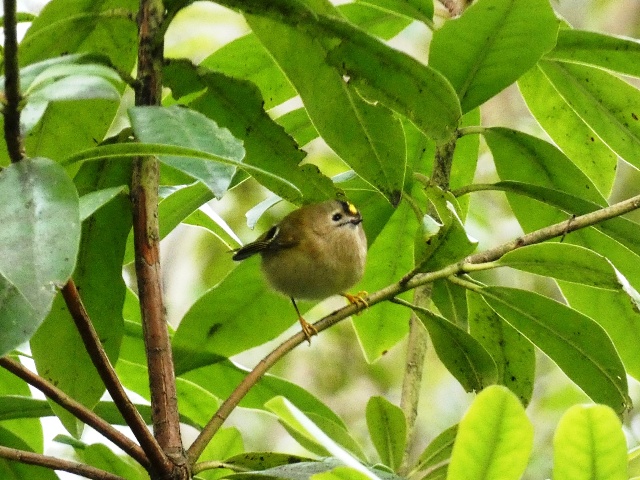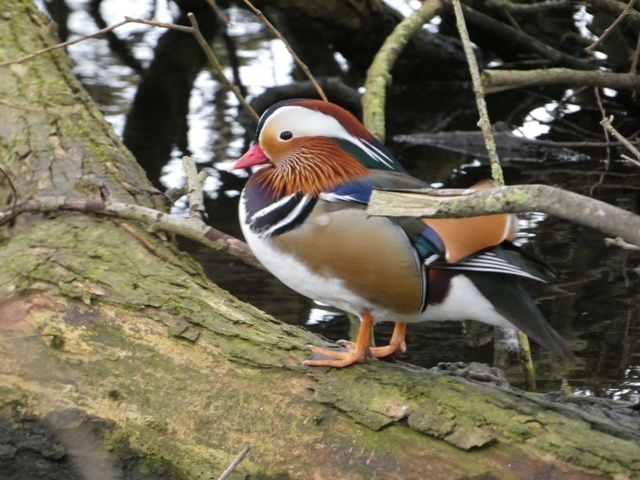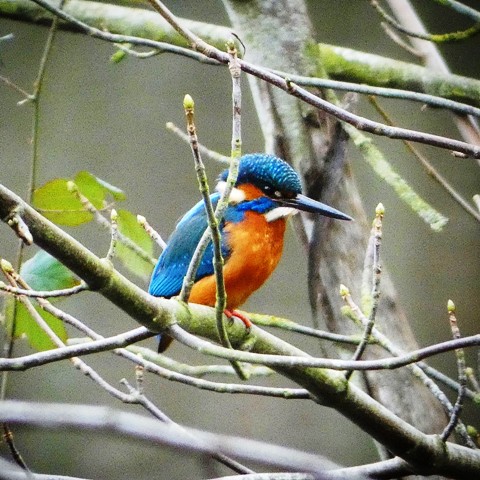Field Meeting Reports – 2023
Lunt Meadows – Sunday 17th December 2023
Several groups of Pink-footed Geese flew overhead as we met in the car park, heading to fields on the other side of the River Alt. Their attractive “wink-wink” calls were very audible.
Walking into the reserve, the sun was shining, highlighting the colours of the many duck on the lakes. There were numerous Mallard, Teal, Shoveler, Wigeon and Gadwall. A single drake Pochard and a Great-crested Grebe were added to the list. Here there were feral Canada and Greylag Geese. A female Stonechat hunted along a low hedge.
We walked further, reaching the river which we followed back. There weren’t too many birds on this stretch but as we neared the Pump House, we saw masses of Pink-footed Geese in the fields just across the river. I estimated there were 3,000 – 4,000 birds! Lapwings and Starlings were also in the fields here.
We eventually came away and returned to the cars for lunch. While we chatted, we noticed an amazing double Cloud Rainbow high in the sky – a new meteorological phenomenon for us all.
After our refreshments, we explored the rest of the reserve. We saw 2 Mute Swans and a couple of Herons plus Tufted Duck and a huge Great Black-backed Gull. A male and female Goosander were joined by a second pair.
Then suddenly, the hundreds of Pink-feet took to the air and dispersed to all points of the compass. What an incredible sight and sound to witness.
Sadly, we didn’t see any Barn Owls on this visit, despite waiting until it was almost dark. We did enjoy a lovely, golden sunset across the reeds though, that James captured.
Hugh
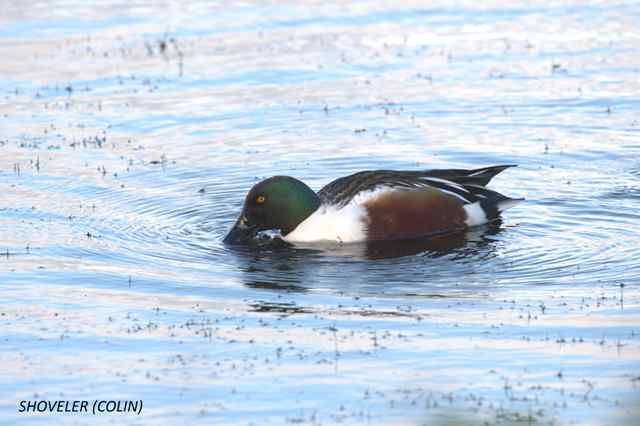
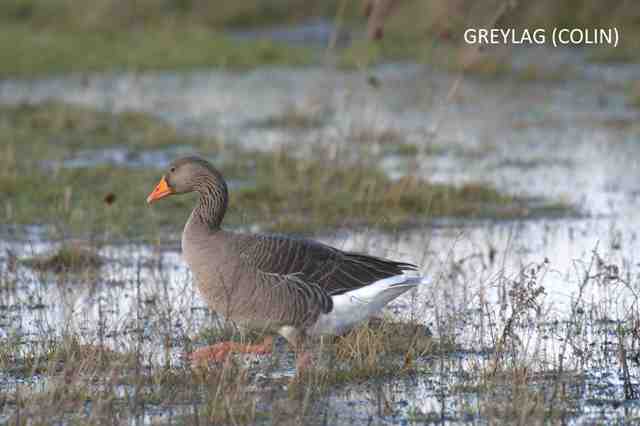
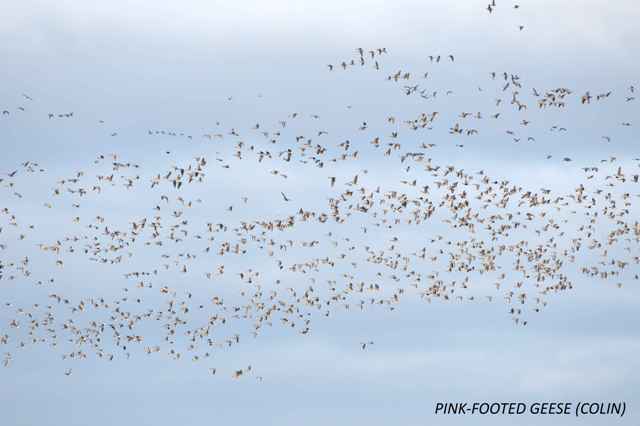
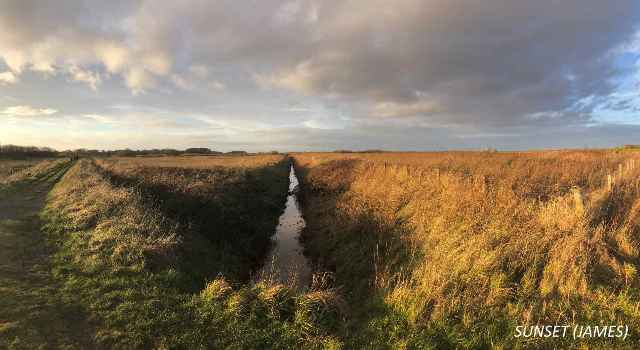
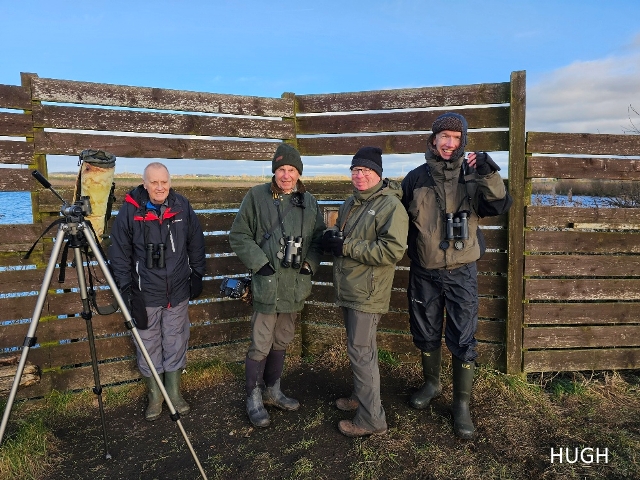
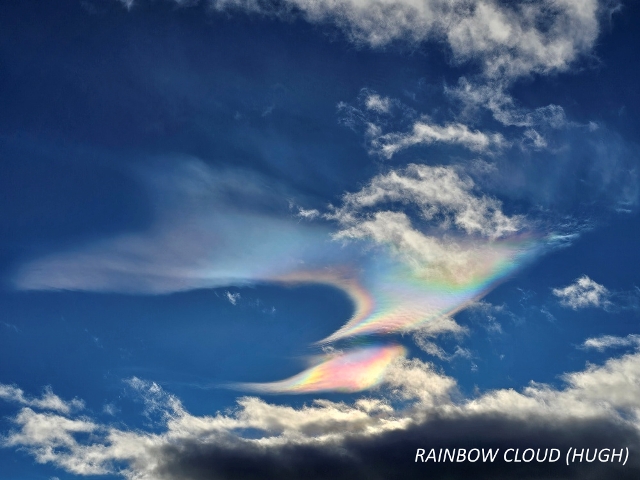
The Spinnies Aberogwyn and RSPB Conwy – Saturday 18th November 2023
The distance to The Spinnies was a little further than we usually drive, but it was certainly worth the effort, as we had a very productive day.
We congregated on the beach looking out towards Anglesey and the mouth of the Menai Straits. The tide still had a while to come in and most of the birds were scattered over wide expanse of mud. So, we headed off to the reserve proper. The pools at the first 2 hides were unfortunately pretty bird-less but the feeders were busy with the common Tits, Nuthatch, Goldfinch and a male Great Spotted Woodpecker. Reaching the final double-sided hide, the birding really improved.
The view of the pool here included a Little Egret busy feeding in its favoured spot and raucously seeing off two intruders!
On the river, we got much better views as the tide pushed the birds closer. Goosander, Red-breasted Merganser, Great-crested Grebe, Wigeon, Shelduck, Goldeneye and at least 8 Little Grebes, plus many more species were ticked off. Two Greenshank were picked out from amongst the numerous Redshank.
On the return to our cars, a large flock of Curlew had settled in a field to roost. Due to the undulating ground, it was difficult to count them all together, but we estimated there were around 140-150 birds – a lovely sight. Gary and James saw a Yellowhammer around this same area – a good sighting.
After a quick lunch we headed on to Conwy RSPB. Here we added Pochard, Gadwall, Shoveler, Lapwing, Cormorant and Reed Bunting and more. A yell of “Kingfisher” from Paul made us all look around but not in time for anyone else to see it. A lot of ribbing followed! A female Bullfinch was similarly elusive, as was a brief view of a Greenfinch that Joyce spotted.
We ended the day with well-deserved refreshments in the cafe! A good winter total of 58 species was seen by the group – although not every species was seen by everyone. (Hey Paul?!).
Thank you to everyone for coming along.
Hugh
Photos by Hugh
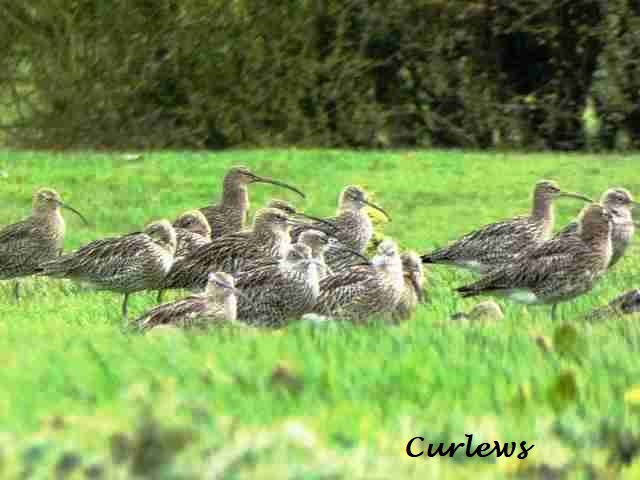
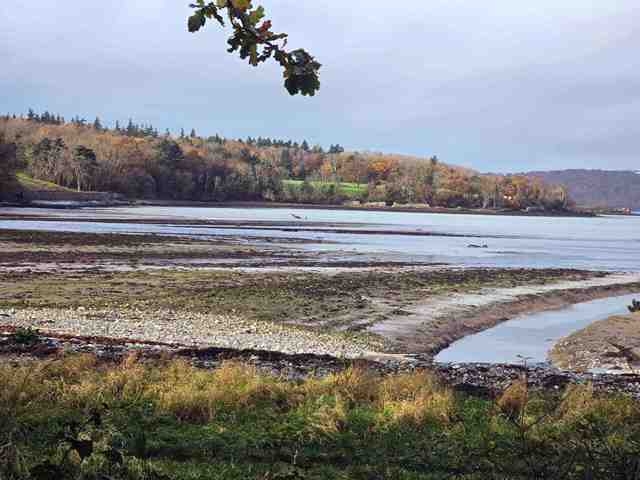
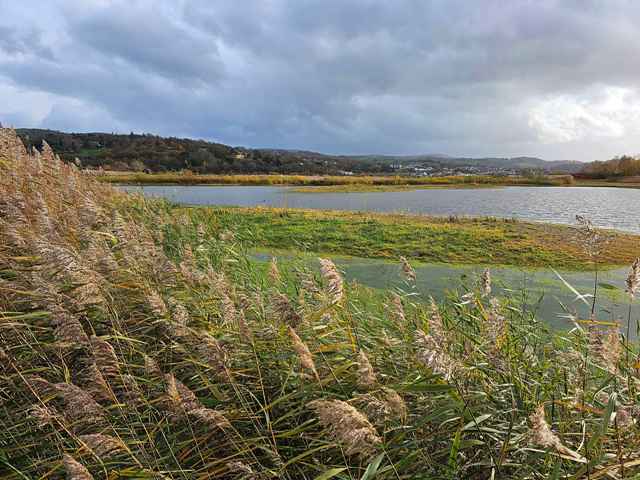
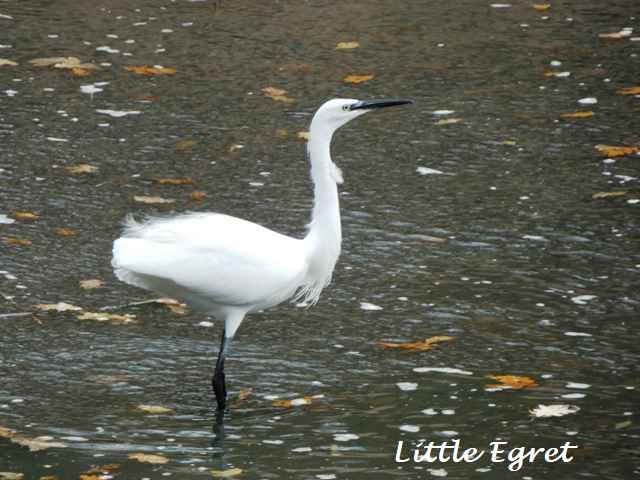
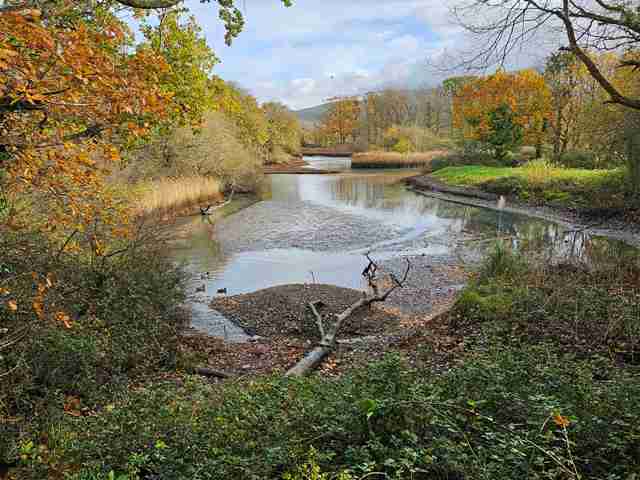
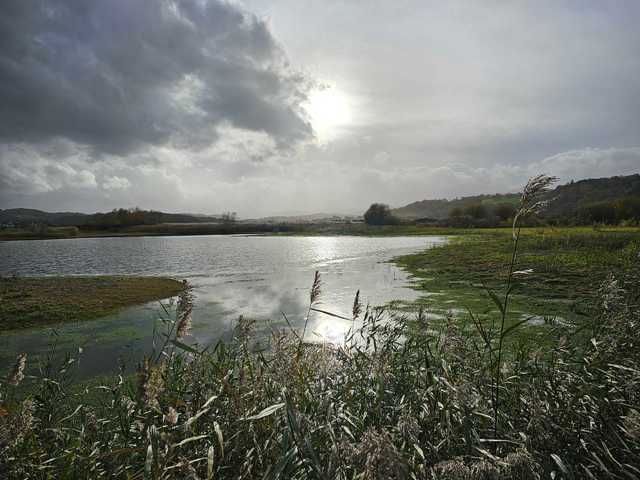
Port Sunlight River Park – Sunday 29th October 2023
This was the Club’s first visit to PSRP and we could not have asked for better weather – dry, calm, with plenty of sunshine. Most of us had put on more layers than we needed and were stripping off or unzipping before the end of the walk!
The leaves were starting to change into their autumn colours, but most trees were still adorned, making the birds difficult to spot. That’s my excuse! A Wood Pigeon was noted though gorging on rose hips, and Robin and Great Tit were seen briefly. A flock of around 25 Curlew flew over, presumably relocating from the shore to a roosting site over the high tide.
Reaching the edge of the Mersey, we peeked through the branches to see several Teal swimming in the calm waters. A pair of Pintail, the first of the winter for me, were sadly elusive. A little further on we got better views of the river, and several Shelduck were mixed in with 5 species of gull.
We found a sheltered spot and enjoyed surveying the Liverpool and Wirral skylines in the warm sunshine.
We finally tore ourselves away to continue along the riverside path. The tide was well in by now and we didn’t see much bird life on this stretch, other than the usual Magpies and the occasional Cormorant. We settled for watching ships heading for the Manchester Ship Canal.
Reaching the Café (sadly closed), we stopped for elevenses. A couple of Redshank flew low over the water calling and a Pied Wagtail passed overhead.
After our break most of the group made the small hike up to the summit of the Park. There is more open habitat here, and part has been fenced off to encourage breeding Skylarks and Meadow Pipits. We saw neither species today, but we did encounter Greenfinch, Carrion Crow and more Magpies. Descending again we reached the lake. Scanning the edge of the reedbed carefully, 4 Snipe were picked out. A Cetti’s called loudly from deep in the reeds. A Buzzard soared high on a thermal and a Goldcrest was elusive in a treetop.
We may not have ended up with a massive bird list, but it was an enjoyable visit to a site that has been transformed.
Photos courtesy of Anne and John Carus and Hugh.
Hugh Stewart
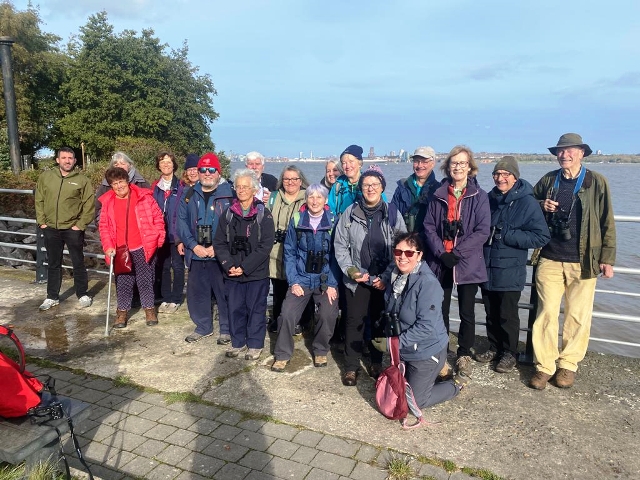
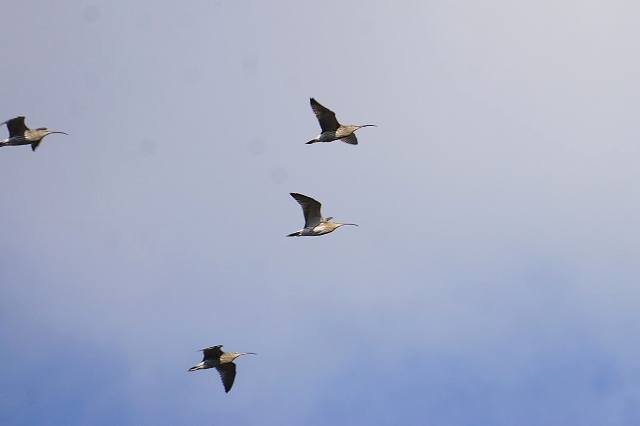
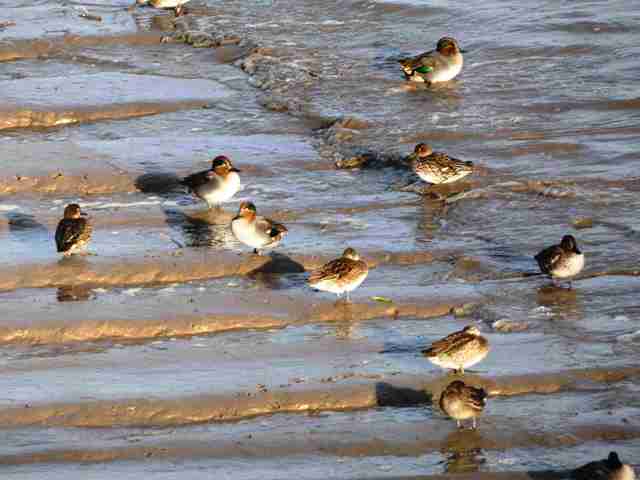
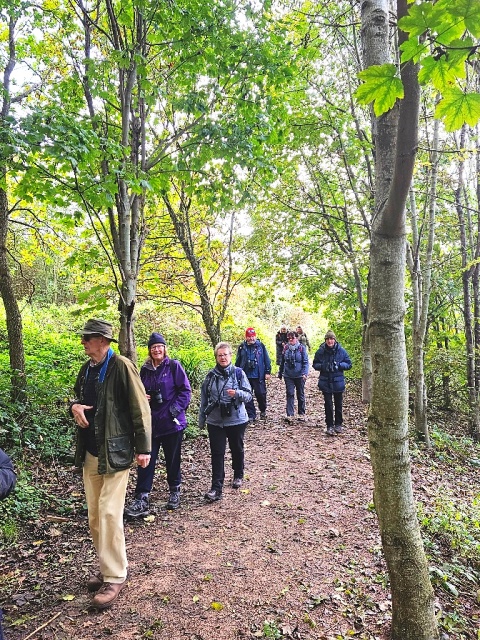
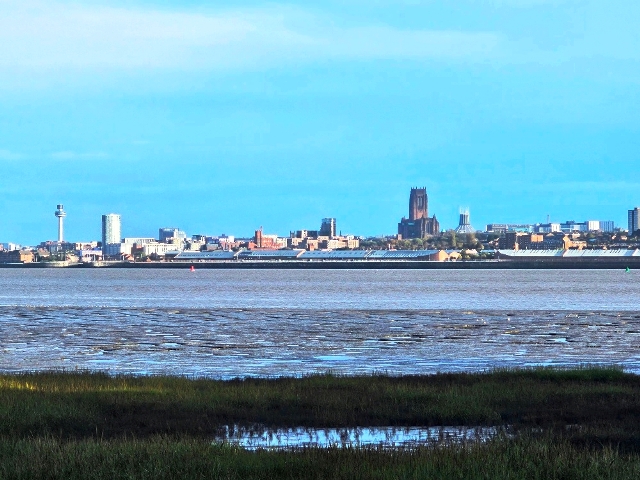
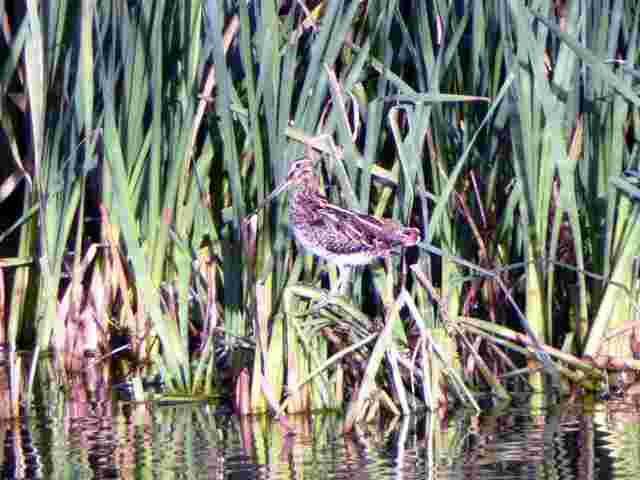
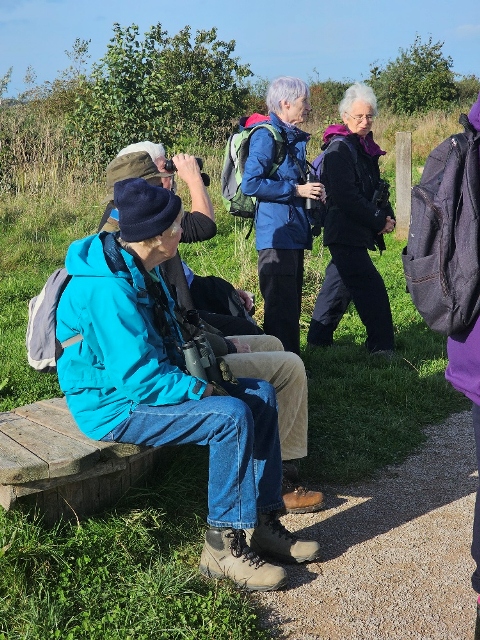
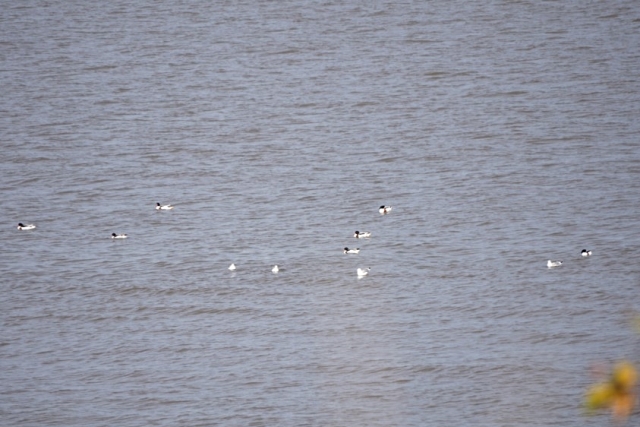
RSPB Burton Mere Wetlands – Tuesday 26th September 2023
We had a great turn-out at our first Field Meeting of the new Programme at RSPB Burton Mere Wetlands. We congregated in the Visitors Centre and scanned the Scrape, immediately noting lots of Black-tailed Godwits, Snipe, Lapwings, Shoveler and Teal. A reported Pectoral Sandpiper eluded us initially, but when we moved on to Bunker Hide, we finally spotted this American wader. A pair of Buzzards then spooked all the waders on the Scrape! A single, late Swallow passed overhead briefly.
Walking around the meres yielded an Egyptian Goose and Tufted Duck.
The Beales were fortunate to see a Great Egret from the Reedbed Screen, and pointed it out to Bill. (The photo by Bill is actually of another Great Egret seen earlier in the year but from the same place). Needless to say, the Egret had disappeared by the time the rest of us arrived! Cetti’s Warblers were calling loudly in the same area though. Two small flocks of Pink-footed Geese passed over us, low enough to hear them calling.
Marsh Covert Hide was quiet apart from three Coot, so we walked a little further to Bridge Screen. Here we added Little Grebe, Shelduck and Gadwall.
As a few spots of rain began, the majority of us returned to the Centre for lunch.
Charles and Alison walked on to Border Hide where they were rewarded with Little and Cattle Egrets along with more Godwits.
We listed just over 40 species as a group, and it was an enjoyable, relaxed time together after the summer break. We will have to come back when the new Café is open!
Acknowledgements to Charles and Alison, Bill and Hugh for the photos.
Hugh Stewart
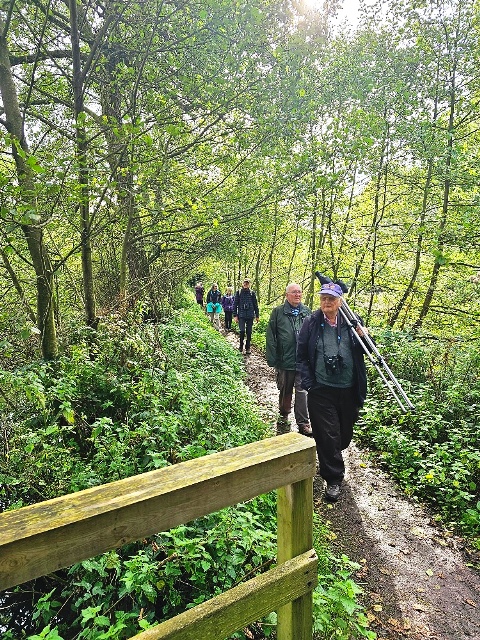
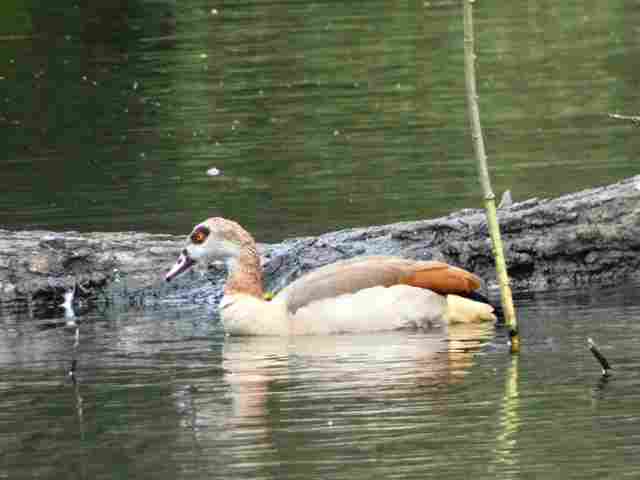
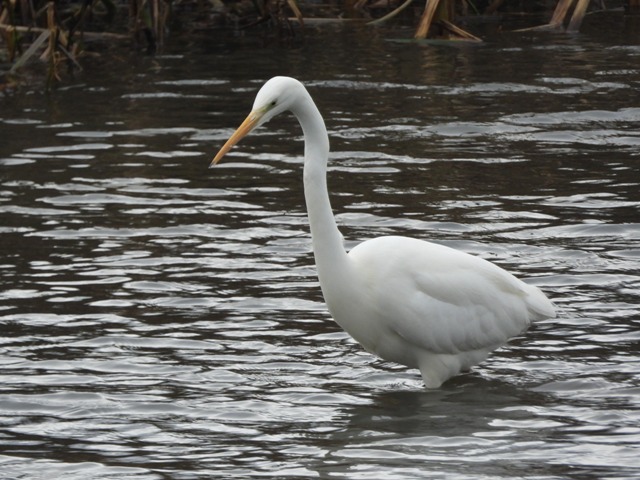
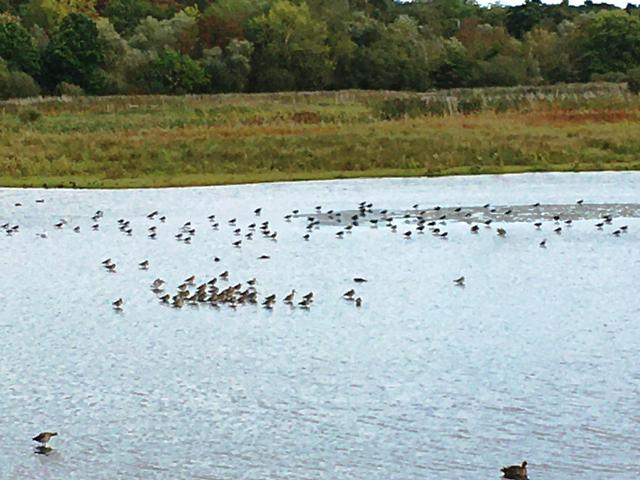
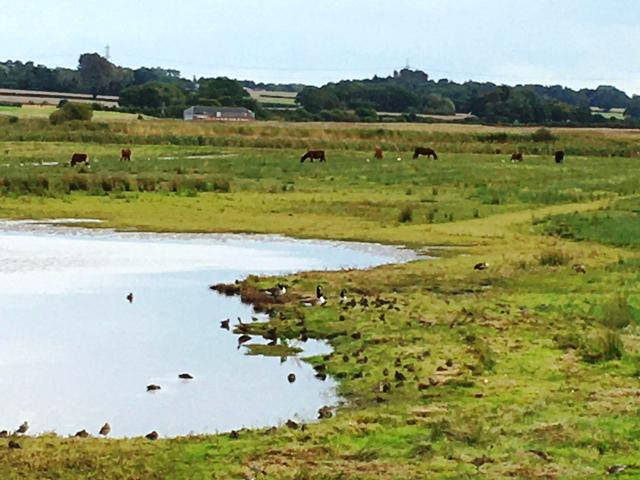
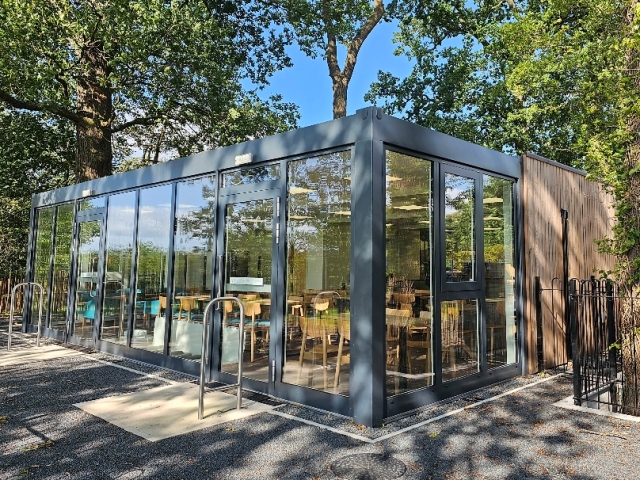
Whixall Moss – Sunday 23rd July 2023
This was a first visit to Fenn’s, Whixall and Bettisfield Mosses National Nature Reserve (to give it it’s full name) for most of the members in attendance, and I think everybody was suitably impressed by the whole day. Firstly, the weather turned out far better than was forecast; and secondly, we were kindly given a guided tour in the morning by two Natural England volunteers, Stephen and Barbara, who imparted their expertise of the Mosses ecology and the special and often rare flora and fauna.
The mosses are a rare example of a lowland raised bog. A lot of work has been done to build bunds to help maintain the water levels that are essential for the bog’s healthy status.
The bird highlights were a spectacular close view from the Mammoth tower hide of a Hobby hunting for dragonflies over the bog, and a fly-past Red Kite viewed from the Charles Sinker Fields Hide. A Kestrel was also seen hovering on several occasions. There were a number of Stonechats dotted around including several juvenile birds which suggests they’d had a good breeding season. The occasional Meadow Pipit, Linnet, Lapwing and Shoveler were seen in flight, all local breeders.
The habitat is not just important for birds though, and we also found dragonflies (see female Black Darter photo) and damselflies, as well as several butterfly species. Striking Brimstones stood out especially, and Red Admirals were admired.
In a small pool we found two Raft Spiders with notable creamy stripes on the body, and green legs indicating they were both youngsters. Adults can grow up to a 3 inch leg span and a 1 inch body!
The plant life was also fascinating. Sphagnum moss is the key species the bog, absorbing the rainwater and eventually dying with other vegetation to form the underlying peat. The bog is acidic and poor in nutrients, so insectivorous plants are found here including sundew and lesser bladderwort.
A big thank you to Stephen and Barbara for their time and passing on their in-depth knowledge. It’s never too late to learn!
The accompanying photos are from Andrew (the fauna) and Hugh (group, habitat).
Hugh Stewart
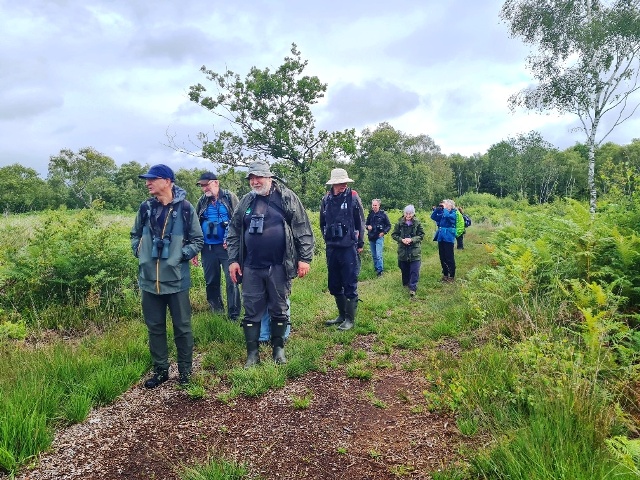
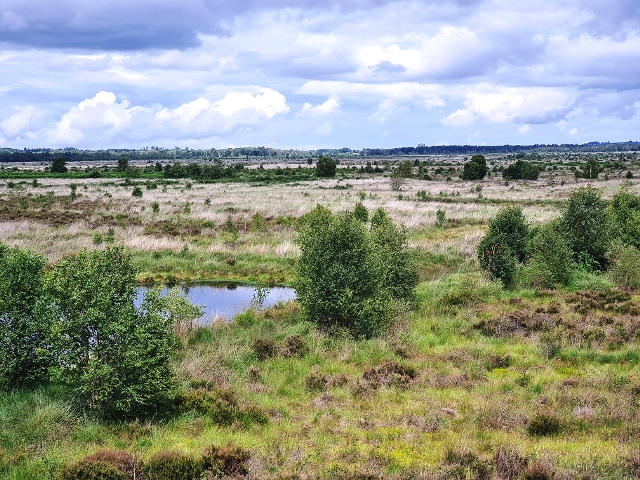
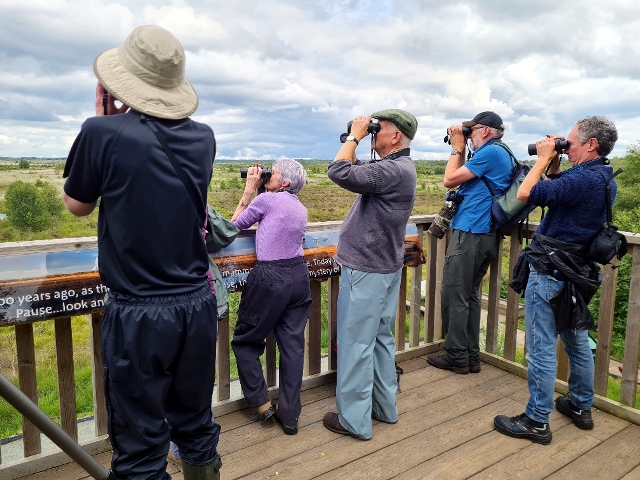
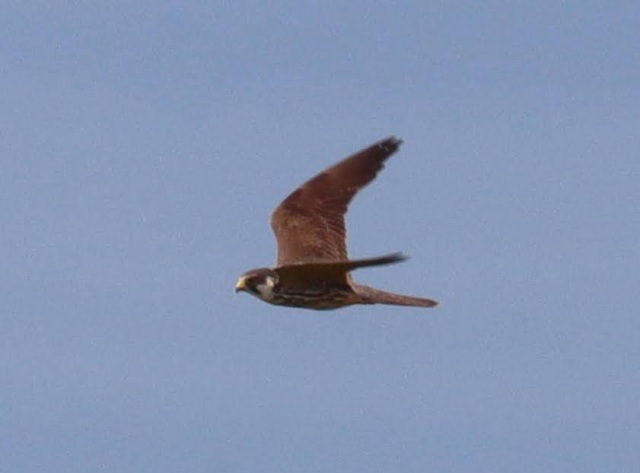
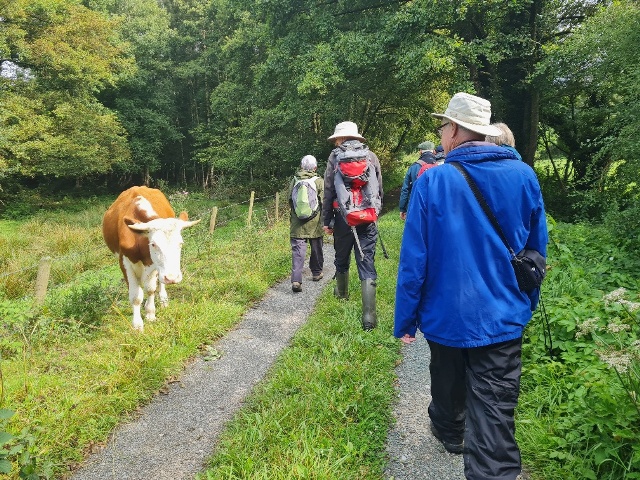
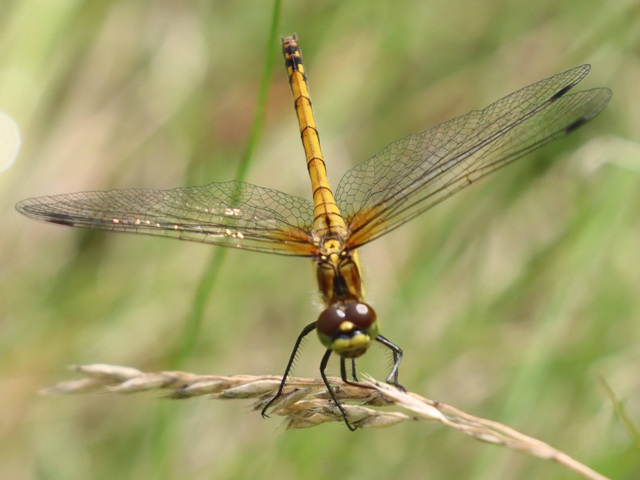
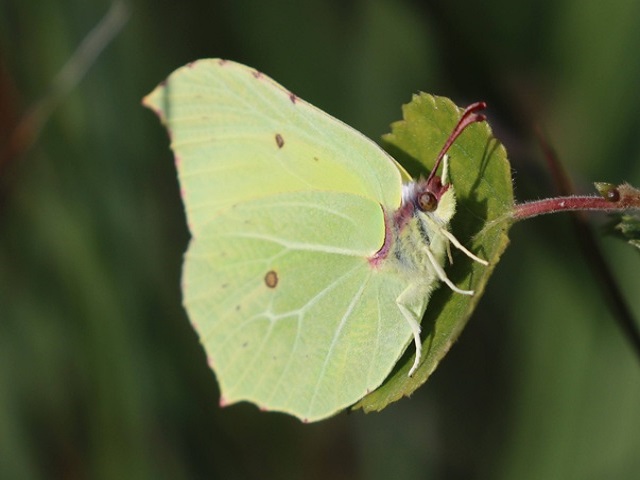
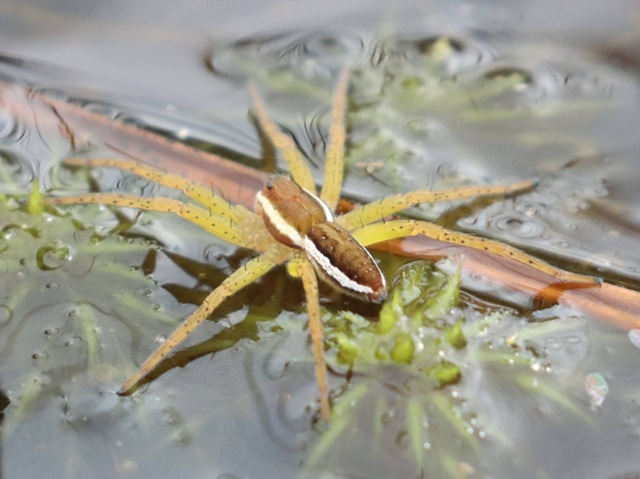
RSPB South Stack – Saturday 10th June 2023
With perfect conditions, we enjoyed the magnificent scenes at South Stack at their best.
On arrival, we quickly descended to the cliff top near Ellin’s Tower, to view the main nesting areas for the seabirds that the reserve is arguably most famous for. Hundreds of Guillemots and Razorbills were perched on the cliff edges sitting on eggs, and more birds were resting and bathing in the calm sea far below.
After a while we started to differentiate more easily between the jet black, larger billed Razorbills and the slightly browner hued Guillemots with dagger bills. Amongst the birds on the water, at least 5 Puffins were picked out. Fulmar, Kittiwake and Herring Gull were also present.
While we were taking in these spectacular sites, Choughs were flying past us at eye level, and one or two settled quite close by.
We eventually tore ourselves away and walked along the cliff edge. Rock Pipits and Skylarks were on the heathland area. There were also loads of Burnet Moths on this area as well as several other day flying moths and butterfly species. Reaching the lane back to the Centre, Whitethroat and Linnet were added to the list amongst other species.
After a welcome stop for refreshments, we headed northwards. A pair of obliging Meadow Pipits were seen well and photographed. Dragonflies were also spotted but not identified. Returning towards the coach again, a pair of juvenile Stonechats sat up and posed nicely.
A brave few ventured down the steps towards the lighthouse and found 3 Puffins near their nest holes. We staggered back up in time for a quick drink in the café before the drive back to Wirral.
I just got in the house before the threatened heavy rain and thunder started in earnest – I hope everyone else got home safely.
We saw 34 bird species as a group, but it was the whole impression of the mass bird activity that was most memorable for me. I think everyone enjoyed the day as much as I did!
Thank you to Ellie, Colin, Bill and Hugh for the photos – there were so many great shots it was difficult to select just a few.
Hugh Stewart
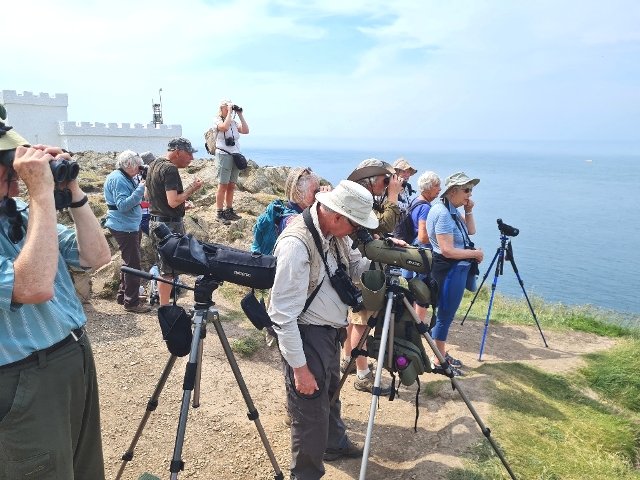
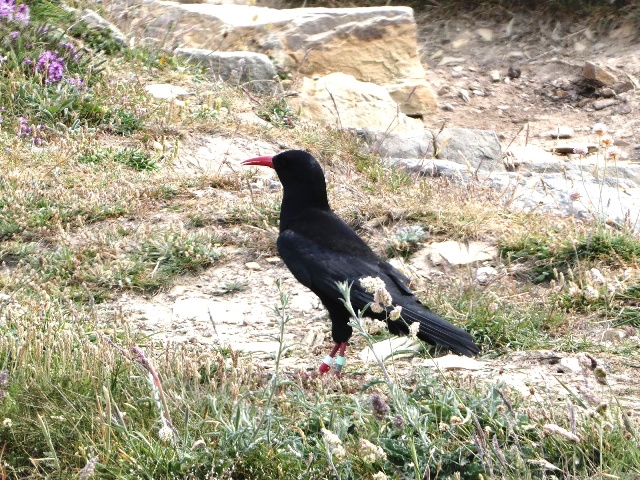
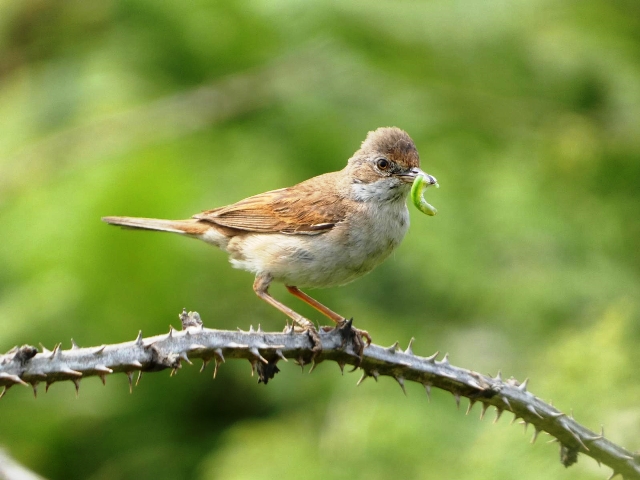
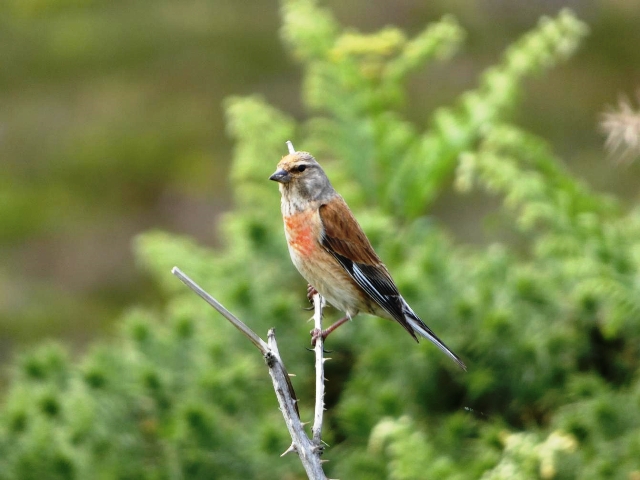
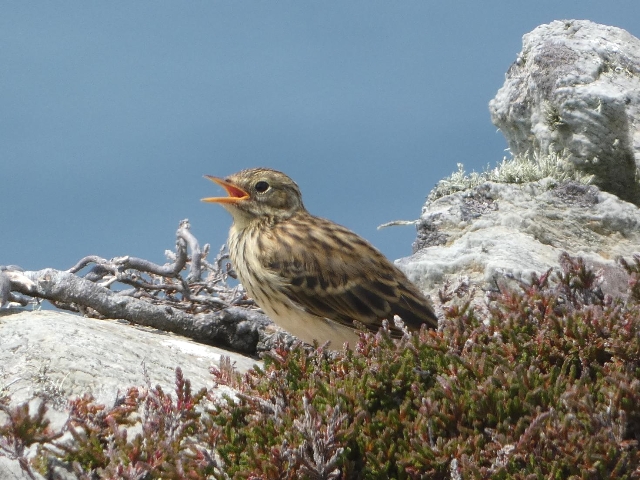
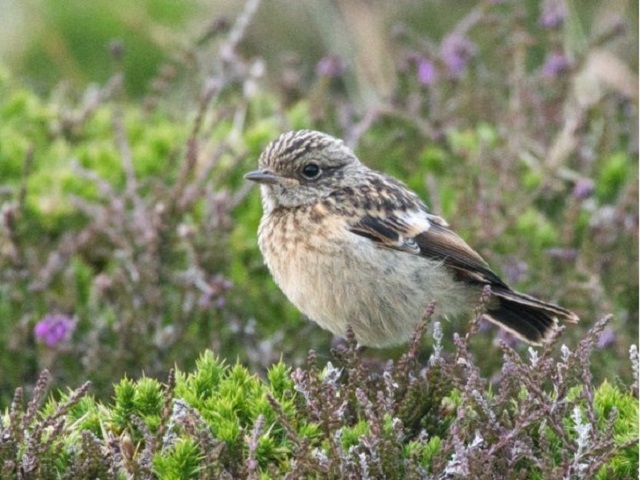
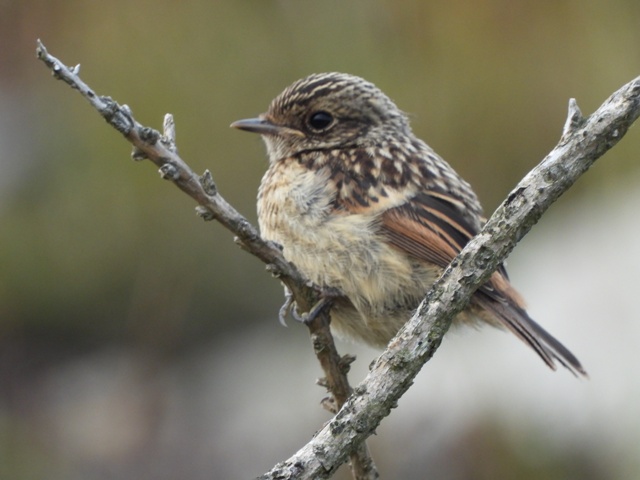
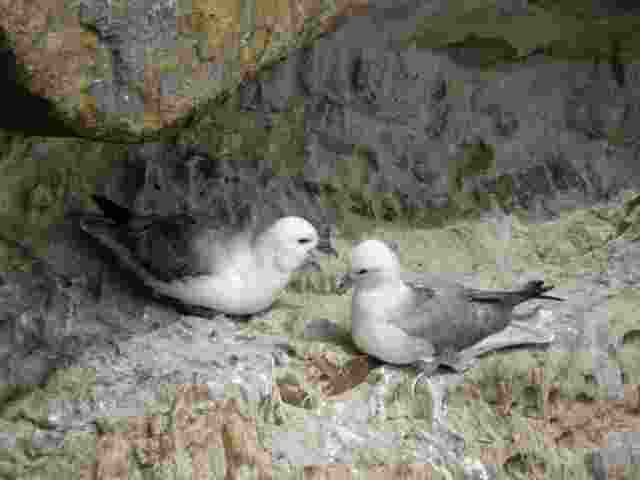
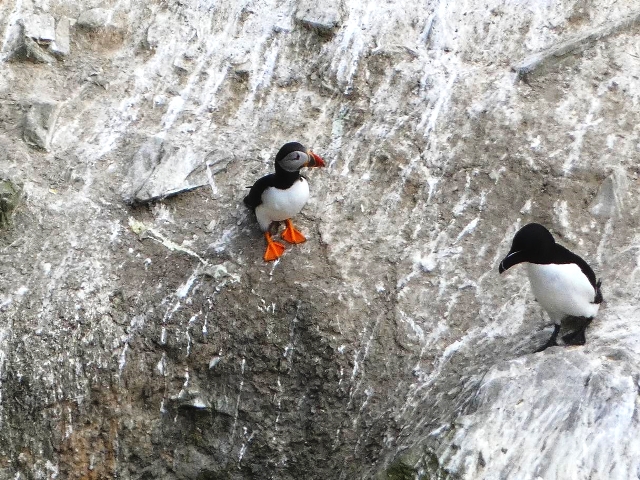
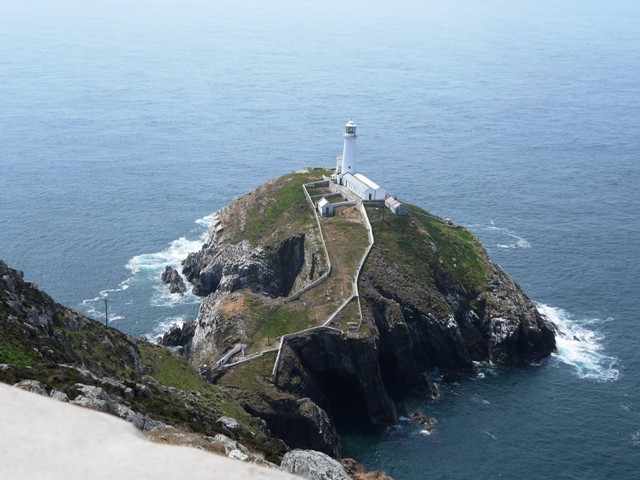
Glyndyfrdwy – Sunday 7th May 2023
In the small village where we met, Swifts and House Martins were flying above us in the glorious blue sky – the first sightings of the year for many of us of these classic summer visitors. Jackdaws and a few Rooks were also noted.
As we started following the Nany y Pandy River up the valley, one of the first birds we came across was a male Common Redstart singing from the top of a tree. Unfortunately, it did not give great views before it flew off, but it was a good start.
Singing Chiffchaffs were common all through the woods, but as we came out into more open, scrubby areas they were replaced by Willow Warblers.
The valley was the site of important slate quarrying in the past, and we found remnants of the old tramways and moss-covered, abandoned buildings. After much searching, a male Pied Flycatcher sang heartily and gave wonderful views from an old Oak. He was joined briefly by a female. Two Dippers flew rapidly past us down stream – blink and you missed them! Two Grey Wagtails were busy gathering nest material.
As the Berwyn range opened up in front of us, we stopped for lunch amongst the bright yellow Gorse, and enjoyed the warm sunshine. A Cuckoo could be heard calling distantly across the moorland. Buzzards were almost constantly present overhead, enjoying the thermals and updrafts from the ridge. A lone Raven passed through.
Eventually we began the descent back to the cars. A male Chaffinch perched nicely on some Gorse. A pair of Mallards was not expected up here! We didn’t list the two chickens though!
The glorious weather helped make the day, but this was a lovely walk anyway with stunning scenery and some classic Welsh woodland species.
Photos courtesy of Ellie and Hugh.
Hugh Stewart
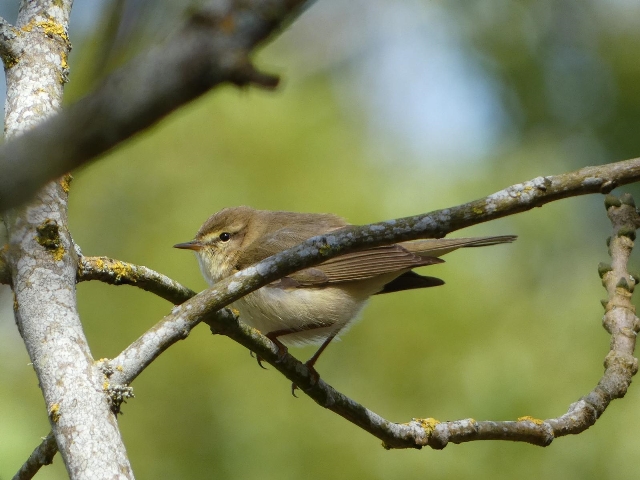
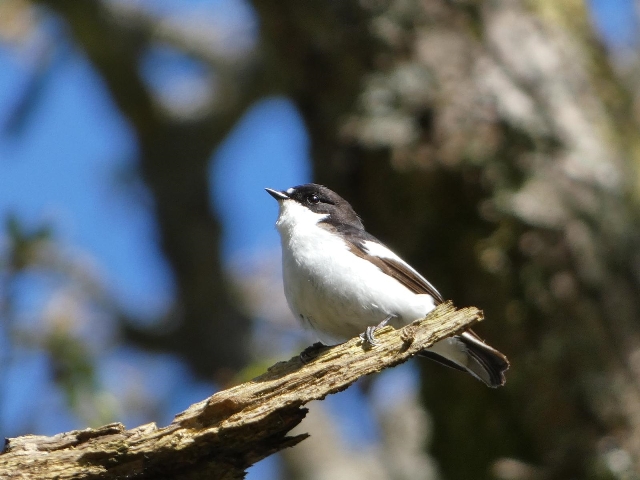
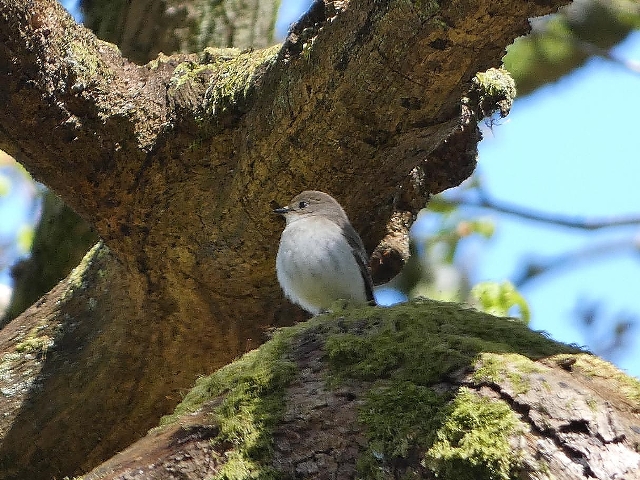
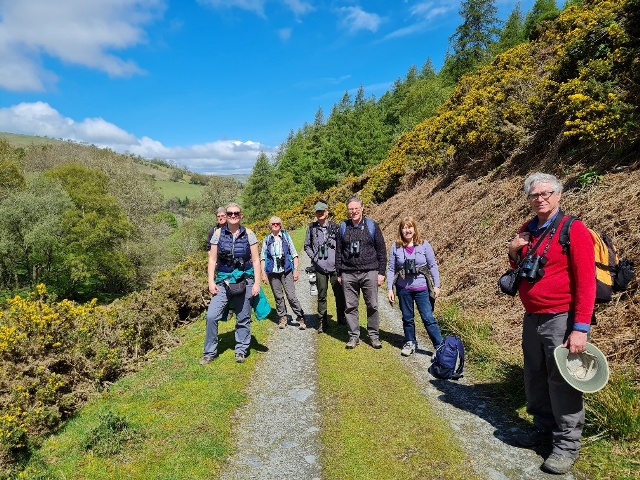
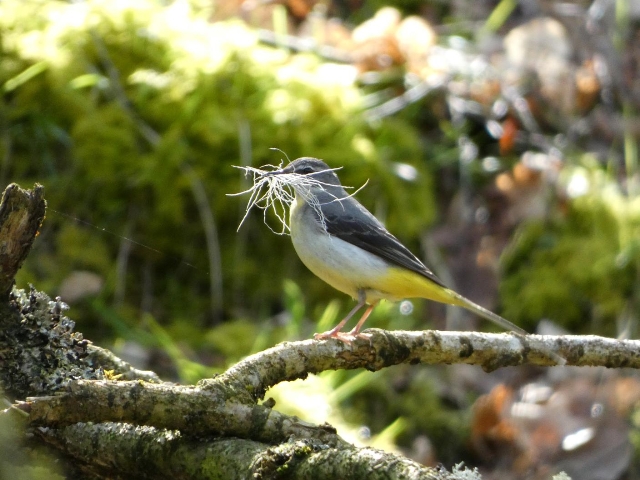
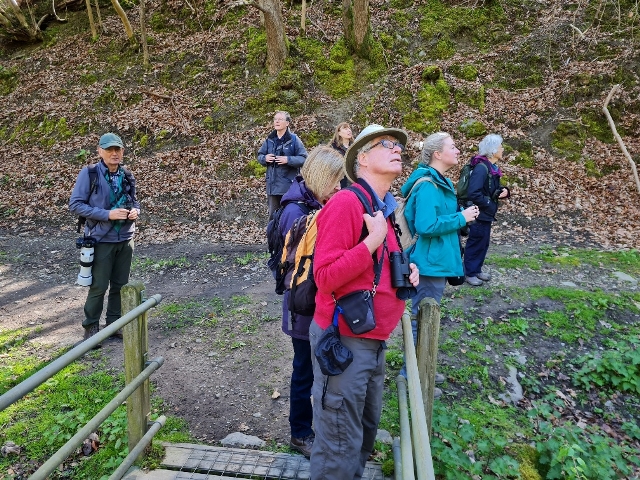
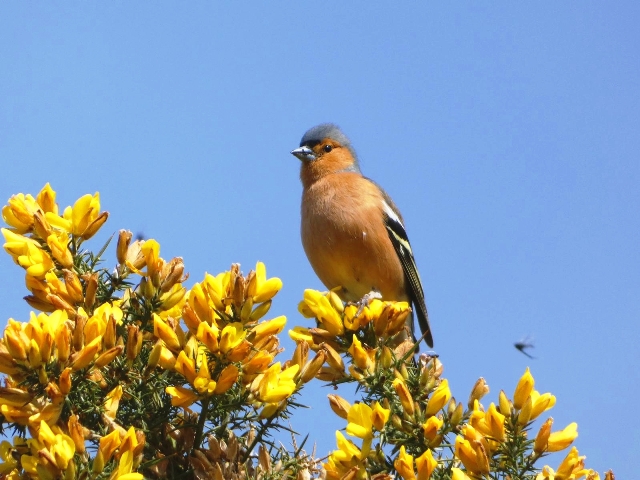
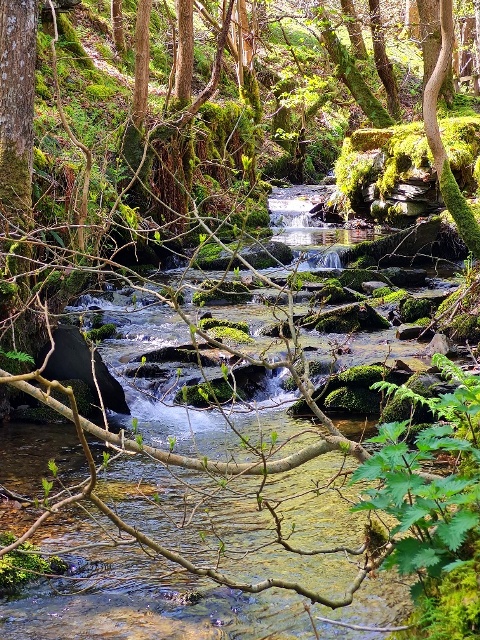
St Aidan’s RSPB (by coach) – Saturday 29th April 202
Our first coach trip for 2023 was to St Aidan’s RSPB reserve.
This is a 355 hectare nature park, located between Leeds and Castleford in West Yorkshire. The land was formerly an open-cast coal mining area that was flooded in 1988, after the riverbank collapsed.
We had 36 people on the coach, including visitors, and the reserve was enjoyed by all. Some people were heard to say that they will definitely revisit.
On arrival, we were greeted by an RSPB member of staff, who immediately took us to see a Little Owl, which was just a matter of yards from the visitor centre, and showing very well. What a great start to the day!
A wide variety of birds were seen throughout the day, including Bearded Tits, Grasshopper Warblers, Sedge Warblers, Willow Warblers, Cetti’s Warblers, Skylarks, Reed Buntings, Pochards, Black-necked Grebes and Great-crested Grebes, to name but a few. Bitterns were also heard booming.
All in all a very productive day on an excellent reserve.
Many thanks to everybody who supported the coach trip, and a reminder that our next one will be to RSPB South Stack on Saturday 10th June.
Photographs courtesy of Bill, Peter Ham and Colin Kendall-Torry.
Bill Wonderley
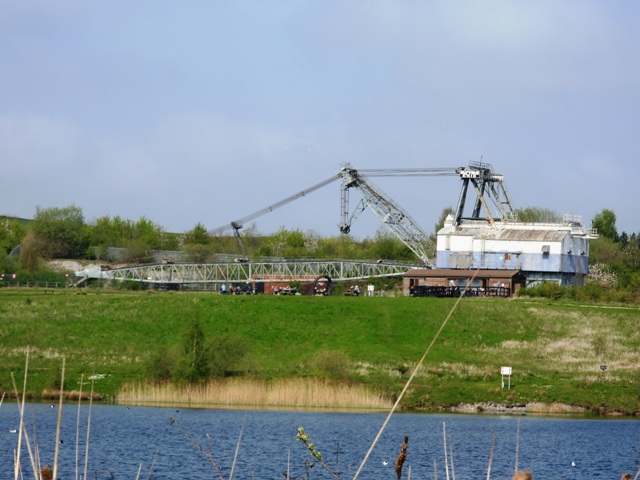
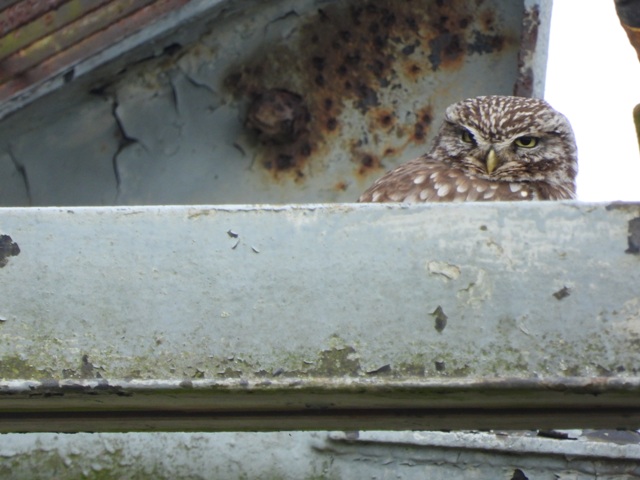
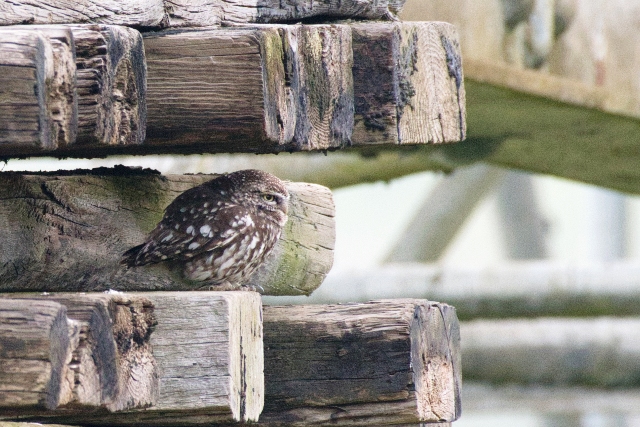
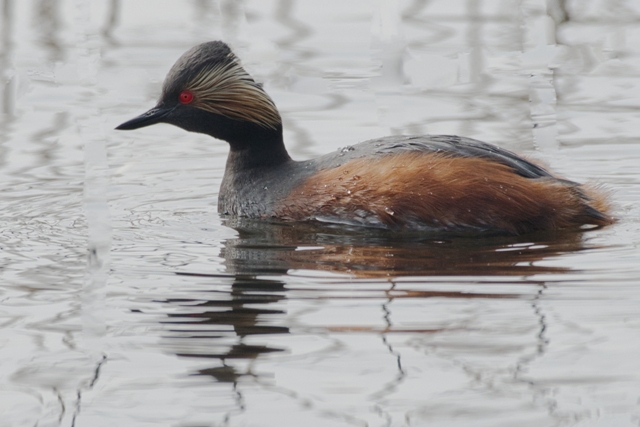
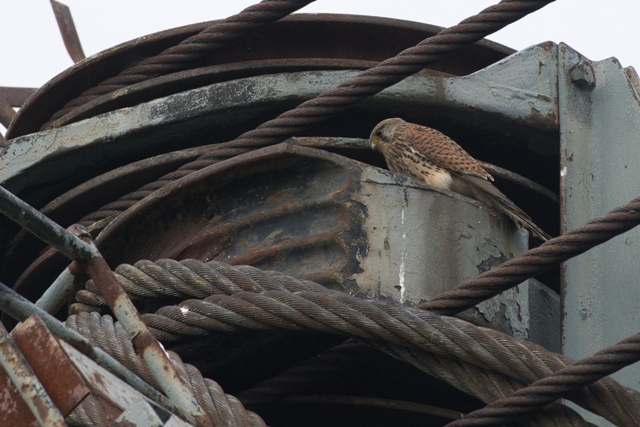
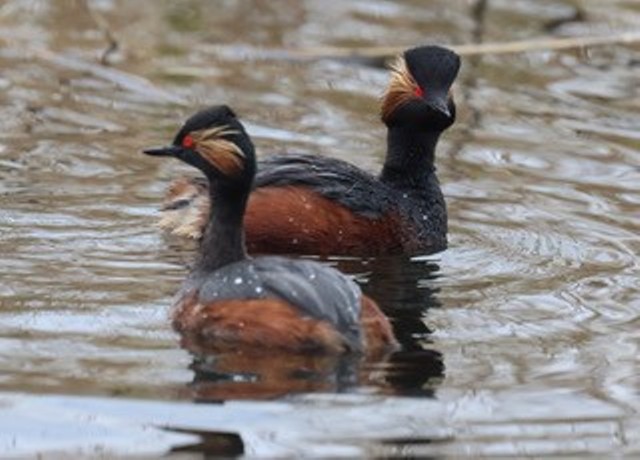
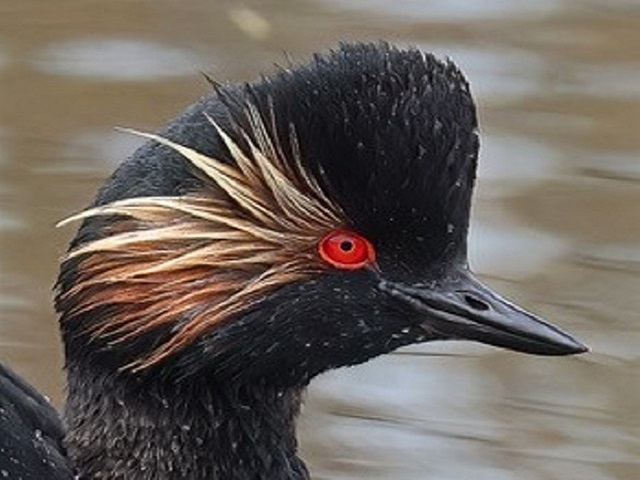
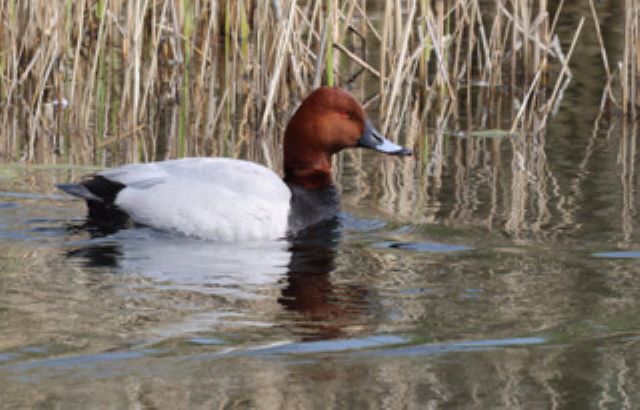
Pennington Flash – Tuesday 21st March 2023
Any visit to Pennington Flash usually results in a good bird list, and our trip there this week didn’t disappoint.
On the main flash there was a nice mix of wildfowl including Mallard, Tufted Duck, Goldeneye, Teal and Gadwall. A pair of distant Common Scoter was unusual for an inland site.
Moving on, a pair of Great-crested Grebes were carrying vegetation to build their nest. A single Snipe was sitting still amongst some reeds, the striped plumage making it blend in perfectly. At the far end of the walk, several Mute Swans flew low overhead, making a wonderful sound as well as an impressive sight.
After lunch, we headed out again. The feeding station at Bunting Hide was mesmerising, with all the expected Tits including Willow, as well as Bullfinch, Nuthatch and Reed Buntings. Interestingly, nearly all the Buntings were males. There was so much activity that you didn’t know where to look next! Treecreepers were seen creeping up and down trees! One Long-tailed Tit was carrying moss for its nest.
The pool at Teal hide held Goosander and Little Grebe. We had been hearing Chiffchaffs all day, and one bird finally showed well in a small bush by the path. The explosive calls of Cetti’s Warblers were heard but typically the birds never showed.
The only hiccup was that the new café was inexplicably closed. Sorry Joyce! Otherwise, everyone had a great day, with 50 species seen or heard, a nice mix of habitat, and good company.
We had so many excellent photos submitted, it was difficult to select ones for this report. A big thank you to Bill, Colin and Ellie for their contributions.
Apologies too to Ellie, Colin and Paul for not acknowledging their photos in the last report on Moore Nature.Reserve.
Hugh Stewart
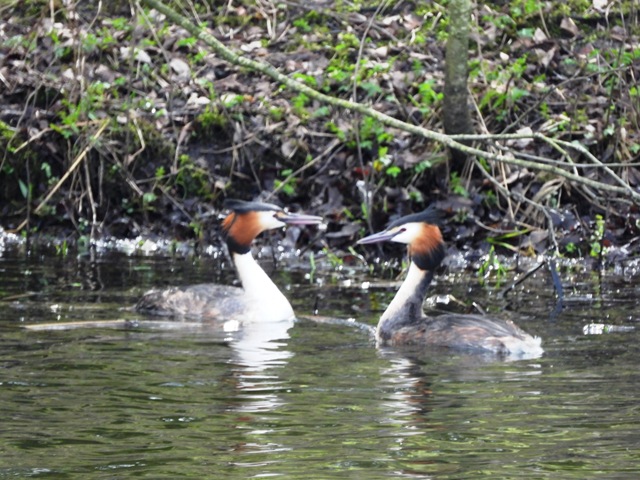
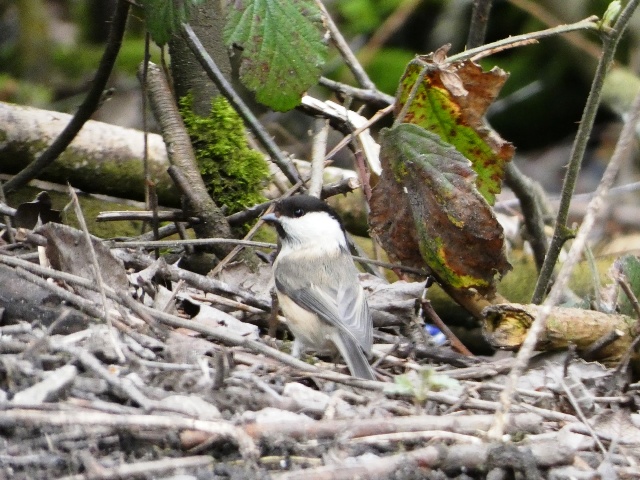
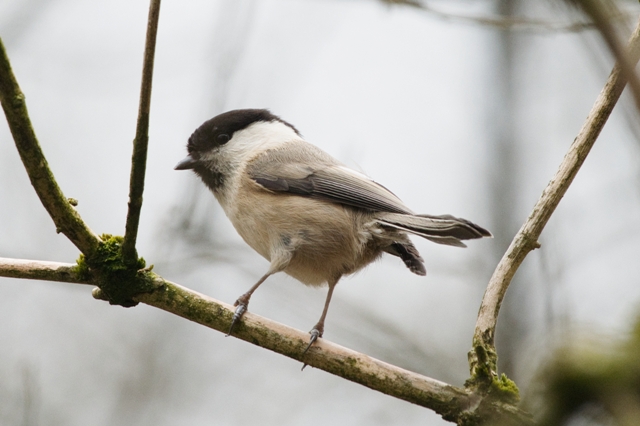
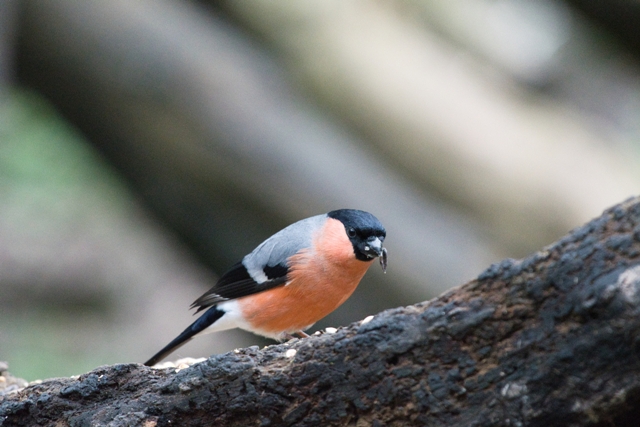
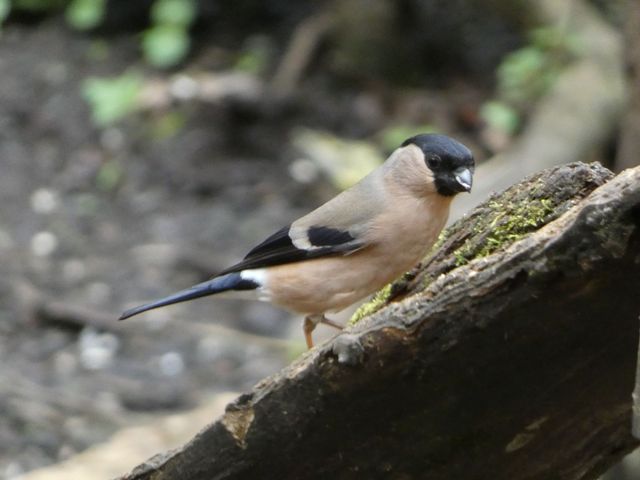
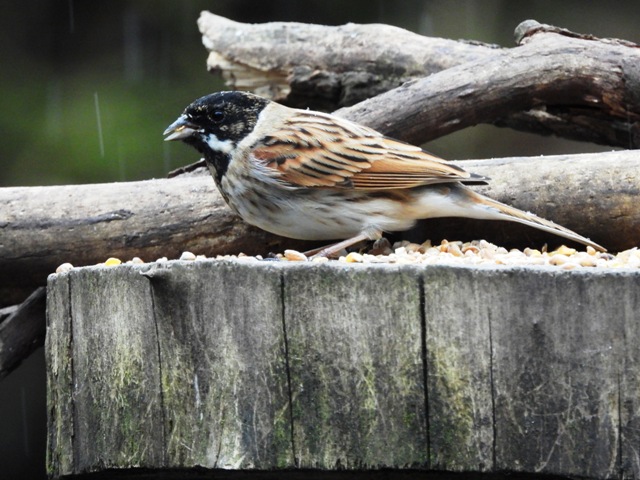
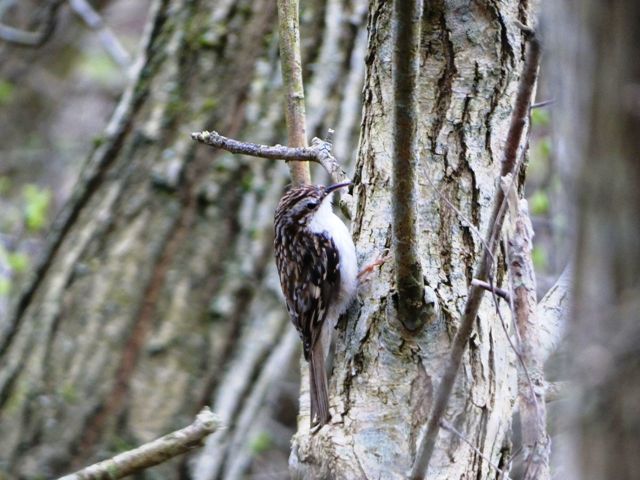
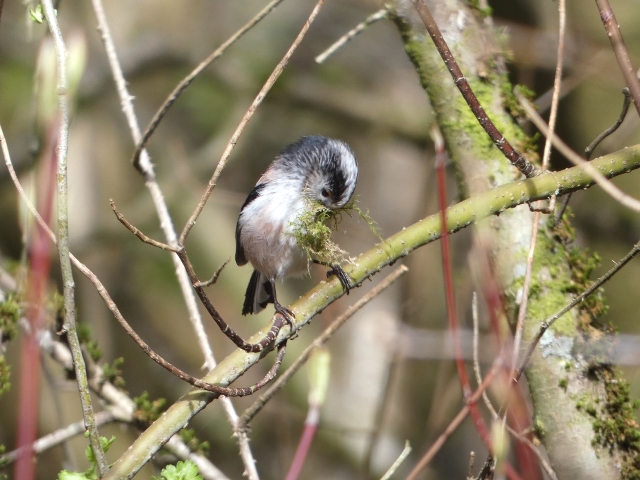
Moore Nature Reserve – Sunday 26th February 2023
We had another great turn-out for Moore Nature Reserve, and a first visit for many members to this site. Our last trip here was in May 2019, according to my records.
A Buzzard on a telegraph pole beside the Manchester Ship Canal was the only raptor we saw all day despite the still, sometimes sunny conditions.
Many of the duck on Lapwing Lane Pool were already pairing off. Several Wigeon gave their evocative whistling calls, while Little Grebes trilled. Mallard, Tufted Duck, Teal and two Gadwall were also present, as well as Coot and Moorhen.
We continued walking around the woods and along the route of the old canal and added Treecreeper, Nuthatch and Goldcrest. The feeding station was not well stocked but still brought in dominant Nuthatch, along with Blue, Great, Coal and Long-tailed Tits and Chaffinch.
After lunch we headed east. Birchwood Pool had a pair of courting Great-crested Grebes, and two pairs of Goldeneye with displaying males. It was truly wonderful to observe these events right in front of us. One or two Redwing fed on ivy berries but were very elusive. OK, we did get a little lost when the woodland path petered out but we finally made our way to Pumphouse Pool! The water was low here, although there were several Gadwall, but we only added Herring Gull, Heron and Goldfinch to our list here.
Somewhat reluctantly we decided at this point to return to the cars. We saw or heard some 41 species between us, with the duck and Grebes very much being the highlight for me. I hope everyone enjoyed the day, and we will have to return during a different season before too long.
Hugh Stewart
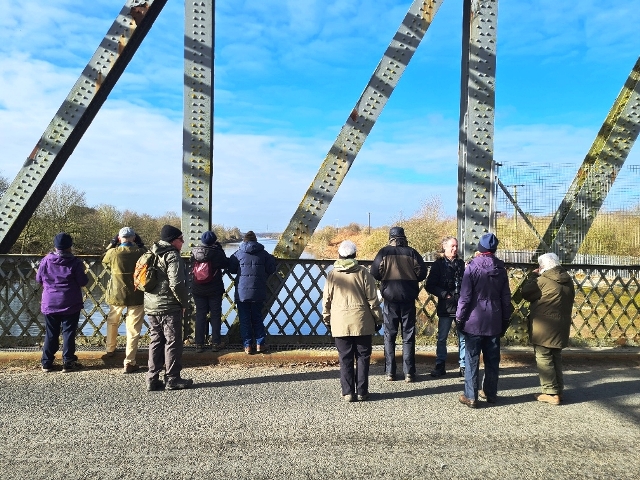
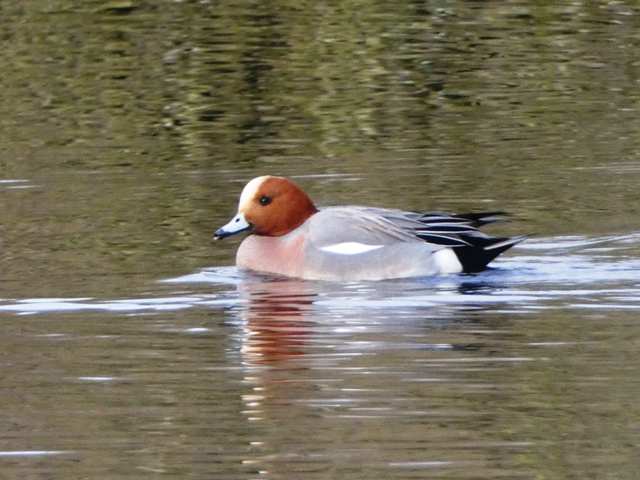
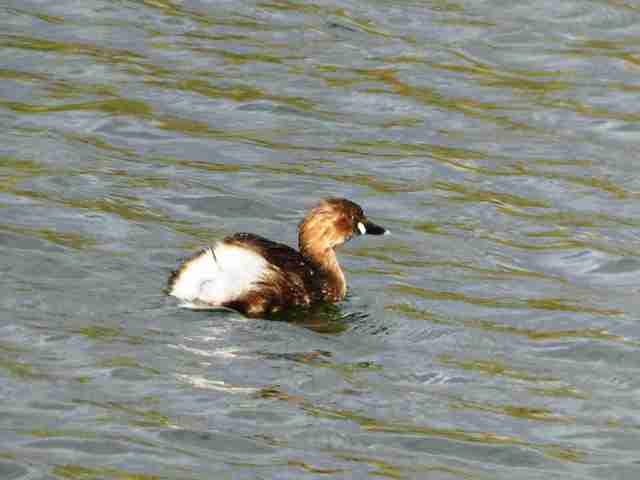
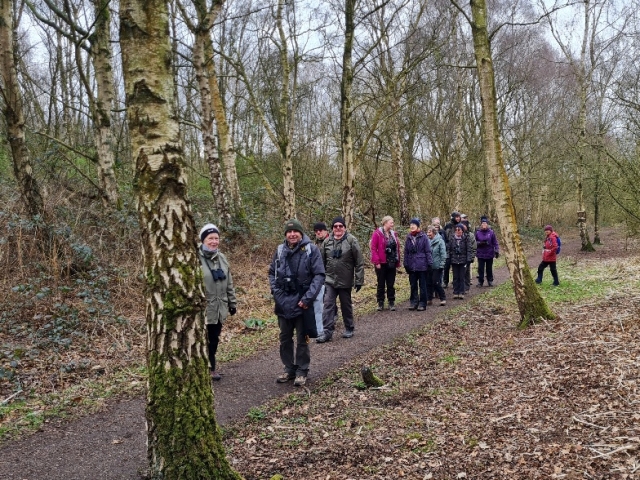
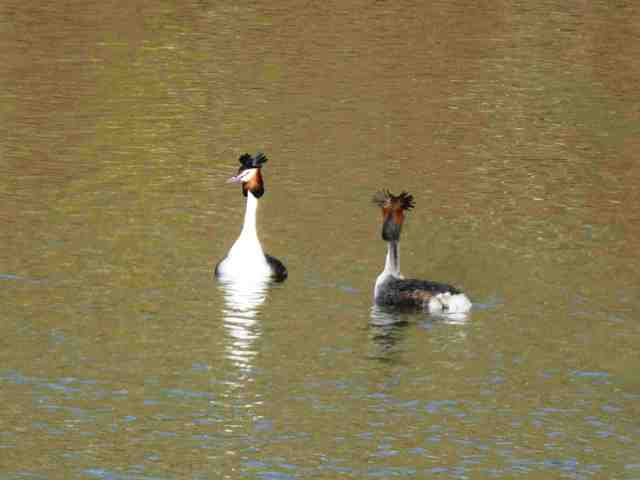
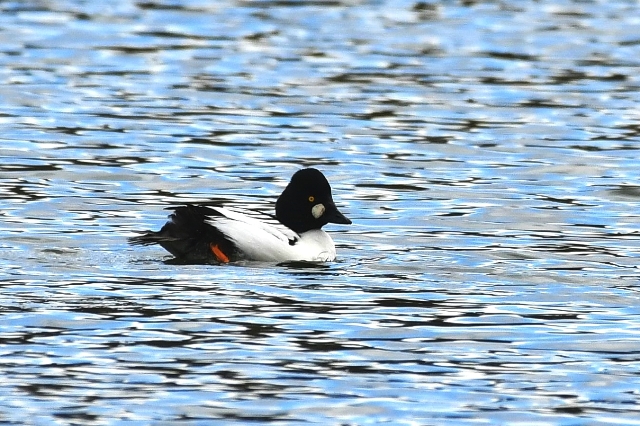
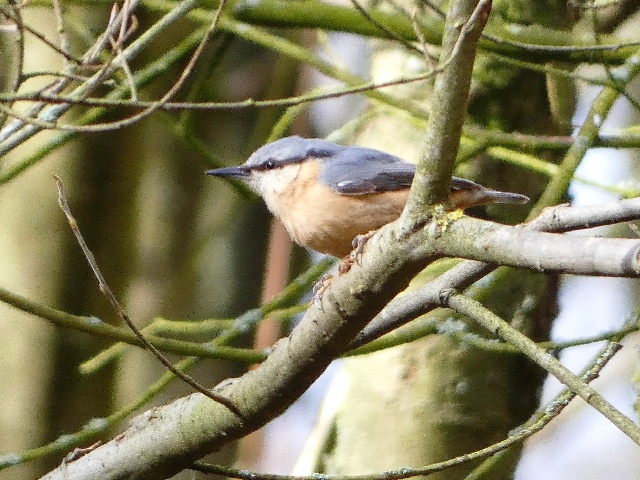
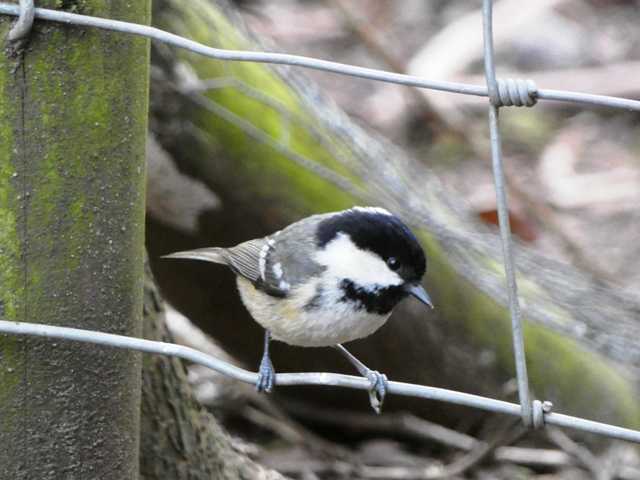
The Shropshire Meres – Saturday 28th January 2023
The Mere at Ellesmere featured the usual eclectic mix of feral duck and geese, including a remarkable Muscovy duck (a species naturally found in South America, Texas and Mexico)! However, we soon picked out plenty of Coot and Tufted Duck.
Two pairs of Mute Swan were not happy with each other’s company, judging by the posturing!
On the island, a small number of Heron were bringing in sticks to reinforce their nests, while a couple of Cormorants perched nearby. More were fishing in The Mere. Two Little Grebes were feeding close to the island.
Walking around the water’s edge we saw many Great-crested Grebes, a few already showing signs of their magnificent breeding head plumage.
At the back of The Mere, lots of Goldeneye were seen, but a pair of Goosanders were rather elusive.
Walking into the trees yielded Robin, Goldcrest and common Tits.
As we returned to the cars, a Mandarin was seen by Ellie and Marion.
After lunch we moved a short distance to Colemere. The woods here were productive with more Goldcrests, two Treecreepers, a flock of Siskin and Nuthatch. There were more than a dozen Goosanders on the water here allowing everyone to have good views at last of these graceful members of the sawbill family.
The final species of the day was an obliging male Kingfisher. We watched it for several minutes, enjoying it occasionally diving and flying on a short distance before landing again. It is always a good day that features one of these colourful birds.
Photos courtesy of Ellie and Hugh.
Hugh Stewart
